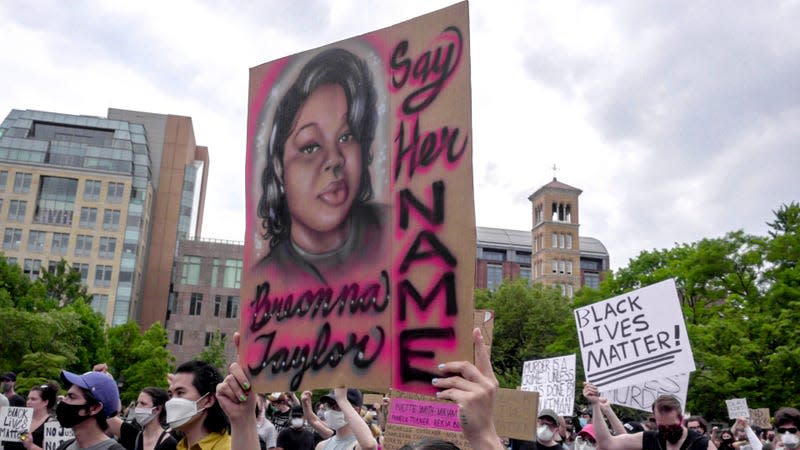DOJ Report: Here Are The Nasty Things Louisville's Police Department Has Done

The Department of Justice released their findings from an investigation into the Louisville Metro Police Department and Louisville/Jefferson County Metro Government, per WDRB News. To no one’s surprise, they were found to have engaged in conduct that violates the constitutional rights of their residents and the federal law.
There’s too much misconduct exposed in the 90-page review to fit in one read, so we picked out the five biggest takeaways.
Read more
Aside from Halle Bailey, Here Are Other Black Disney Actors and Characters We Love [Update]
The Best TV Series, Movies of 2022 to Binge Before the Year Ends [UPDATED]
Megan Thee Stallion Becomes 1st Black Woman to Land Forbes 30 Under 30 Cover
1. Unjustified Neck Restraints
The DOJ found LMPD officers use neck restraints in situations where they really don’t need to use that amount of force. For example, a white officer pulled over a driver for a DUI. When the man refused the breathalyzer test, the officer threw him onto the ground and wrapped his hands around the man’s neck. After handcuffing the man he then pressed his forearm into the man’s neck and another responding officer ran over and dropped his knee on the man’s neck too.
In another instance, an officer responding to an old Black man “dancing in the street” threw the man on the ground and sat on his head and neck - with both the weight of his body and tactical gear - for 30 seconds until bystanders yelled at him to get off.
2. Deploying Dogs for No Reason
In the same section exploring the LMPD’s use of excessive force, the DOJ cited a number of occasions when officers recklessly deployed K-9s to detain suspects. Even when the suspect no longer posed a threat (or didn’t in the first place) they would allow the dogs to gnaw at the person unnecessarily instead of ordering them to stop.
Once an officer deployed a dog onto a 14-year-old boy who they suspected of invading a home. When he noticed the teen lying on the front lawn, he unleashed the dog without warning and the boy was bitten several times. The officer refused the boy’s pleas to restrain the dog under the impression he was not complying with commands - which he couldn’t anyway because his arm was being chewed up. The teen suffered serious injuries and had to be sent to the hospital.
3. Escalation and Weak Oversight
LMPD officers were found to unnecessarily escalate encounters with individuals by startling them, giving confusing commands or inciting anger. As a result, the officers resort to lethal or non-lethal uses of force.
In one case, officers responding to a domestic violence call were told the suspect had a knife. When they arrived on the scene, the officers rushed the Black man, commanding him to put his hands up and pulled him to the ground. They tased him three times without warning and while his children watched.
The reason the department gets away with this nonsense is due to weak oversight.
“Supervisors’ failure to properly identify and address unreasonable force has allowed unlawful conduct to continue. When supervisors decided that excessive force was, in their view, appropriate, they endorsed and perpetuated unlawful conduct,” read the report.
4. Faulty Search Warrants
All eyes were on the Louisville police department after their falsified search warrant led to the murder of Breonna Taylor. The DOJ’s review found that the failure to establish probable cause for search warrants is a common theme.
Often, the requests for search warrants are too broad and based on relationships with their suspects. If you remember, Taylor’s death was a result of the LMPD looking for her ex-boyfriend who used to live with her.
After carelessly securing a search warrant, the officers violated constitutional rights while executing the warrant. Only 2 percent of the time were they found to obtain judicial authorization for a no-knock warrant. Most of the time they carried on busting through doors unannounced anyway. Also, they have a pattern of executing warrants late at night for no good reason.
Breonna Taylor may not have been the only Louisville resident woken out of her sleep to the sounds of police banging on the door or already barging in the living room.
5. Racial Discrimination
Finally, and to the least of our surprise, the DOJ found the LMPD engages in unlawful discriminatory policing acts against Black people. They broke down their findings into to three major points.
First, racial disparities were found across policing activities including searches and arrests. In addition, the LMPD fails to document all of the police encounters they have with Black people, leaving out thousands of interactions. Secondly, the LMPD’s own reports from 2013 to 2019 show they are 50 to 90 percent more likely to search Black drivers than white drivers during traffic stops. Finally, the LMPD fails to respond appropriately to officers who express racial bias toward Black people.
As a result, Black residents feel like they are dehumanized, harassed and humiliated by the police. These findings seem so deep-rooted into the department and government, Louisville needs a complete overhaul of their law enforcement.
More from The Root
15 Priceless Black Twitter Moments Worth Remembering [Updated]
Madea Goes to Amazon: Tyler Perry Lands 4-Year Film Deal With Amazon Studios
Sign up for The Root's Newsletter. For the latest news, Facebook, Twitter and Instagram.

